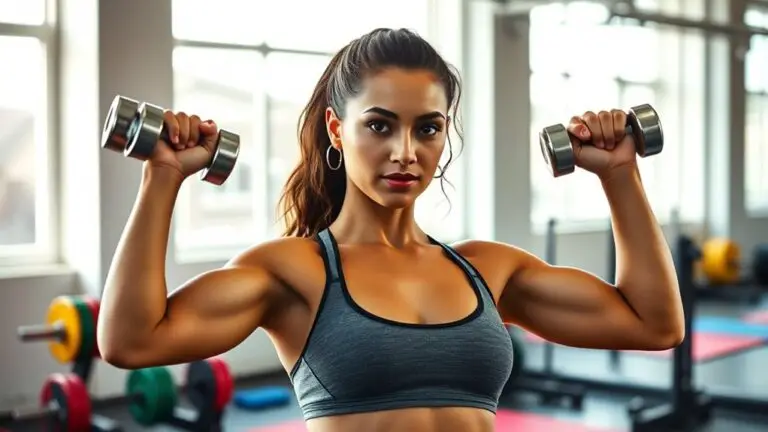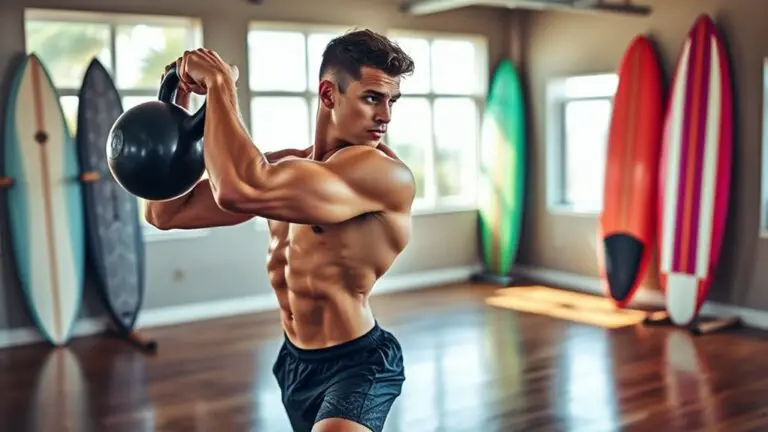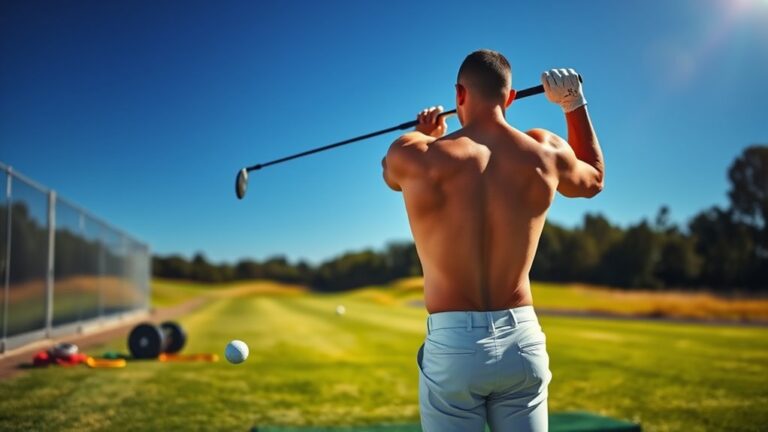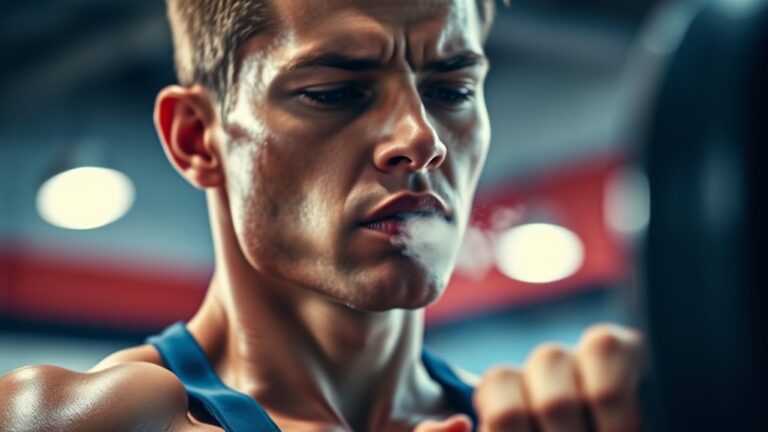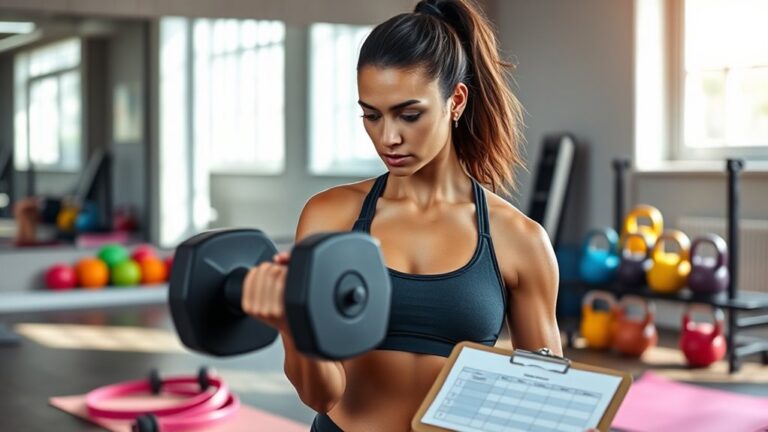How Torque and Leverage Affect Strength in the Gym

Torque and leverage greatly influence your strength gains in the gym. Torque, the rotational force around a joint, increases with greater distance from the pivot point, enhancing power output in exercises like squats and deadlifts. Proper leverage, achieved through body positioning and grip adjustments, can minimize joint stress and maximize muscle activation. Understanding these mechanics not only improves your performance but also helps prevent injuries. Explore how specific exercises can fine-tune these principles to boost your results.
Understanding Torque: The Basics

Torque, a fundamental concept in biomechanics, refers to the rotational force applied around an axis. To grasp the torque definition, you need to understand that it’s the product of force and the distance from the axis of rotation. In practical terms, the further you are from the pivot point, the more torque you generate. This principle underpins various torque applications in the gym, influencing exercises like squats and deadlifts.
For instance, when you lift weights, your body’s joints act as pivot points, and the distance from these joints to where force is applied determines the torque produced. Greater torque results in more effective force generation, enhancing your performance. Understanding this concept allows you to optimize your training technique, ensuring you’re engaging the correct muscle groups while minimizing injury risk. By mastering the fundamentals of torque, you can improve your lifting efficiency and overall strength development in the gym.
The Role of Leverage in Weightlifting
While many athletes focus on the amount of weight they can lift, understanding leverage is equally essential for maximizing strength in weightlifting. Leverage techniques involve positioning your body relative to the weight being lifted, which directly influences the force required to perform the lift. By optimizing your body angles and grip, you can effectively reduce the load on your muscles and joints, enhancing your ability to lift heavier weights.
For instance, the squat’s bar placement affects your center of mass, altering leverage. A low bar squat can provide better leverage for many lifters compared to a high bar squat, facilitating greater strength optimization. Additionally, employing a wider grip in bench pressing can improve leverage, allowing for increased power output. By mastering these leverage techniques, you’ll not only lift more effectively but also reduce the risk of injury, ensuring a more sustainable approach to your training regimen.
How Torque Influences Exercise Mechanics
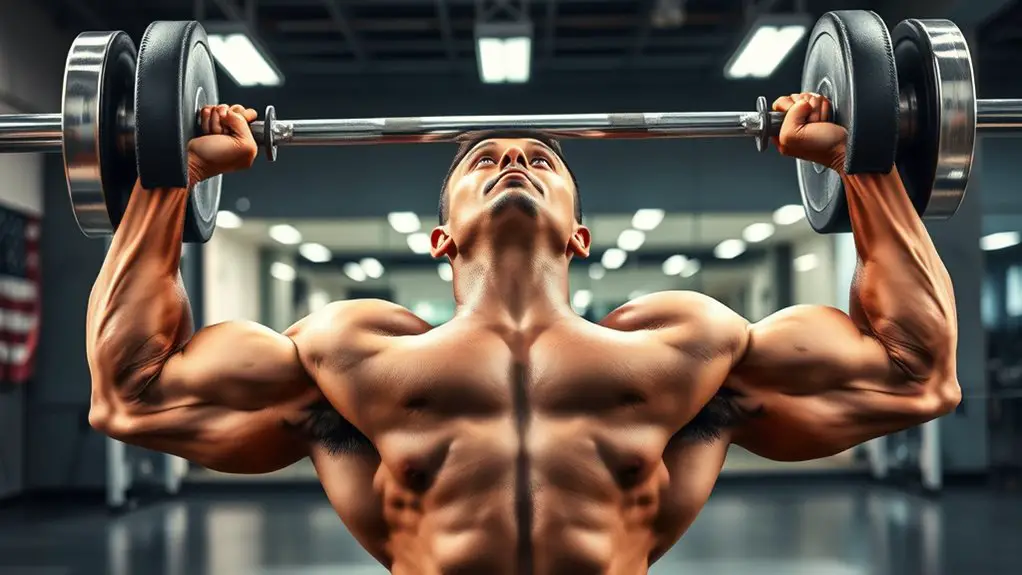
Understanding leverage sets the stage for a deeper look at torque and its role in exercise mechanics. Torque effects are vital in determining how effectively you can generate force during various movements. Here are four key aspects of torque in exercise mechanics:
- Angle of Force Application: The angle at which you apply force considerably influences torque. Ideal angles increase efficiency.
- Distance from Joint: The farther the weight is from your joint, the greater the torque. This means you can lift more effectively if you position the load correctly.
- Muscle Length: Longer muscle lengths can produce greater force, impacting torque generation during lifts.
- Stability and Control: Torque also affects your ability to stabilize movements, which is essential for preventing injuries.
Leveraging Body Position for Maximum Strength
When you position your body correctly during lifts, you can considerably enhance strength output. Proper body alignment plays an essential role in maximizing your leverage. For instance, keeping your spine neutral while aligning your joints effectively guarantees that the force generated during a lift is transmitted through your body. This alignment minimizes energy waste and reduces the risk of injury.
Additionally, core stability is critical for maintaining this alignment. A strong core stabilizes your pelvis and spine, allowing you to transfer power more efficiently throughout the lift. Engaging your core not only supports your body but also aids in maintaining balance, which is important when lifting heavy weights.
Incorporating these principles into your training can lead to improved performance, as proper body position and stability facilitate better torque dynamics, ultimately enabling you to lift more weight safely and effectively.
Common Exercises and Their Torque Dynamics
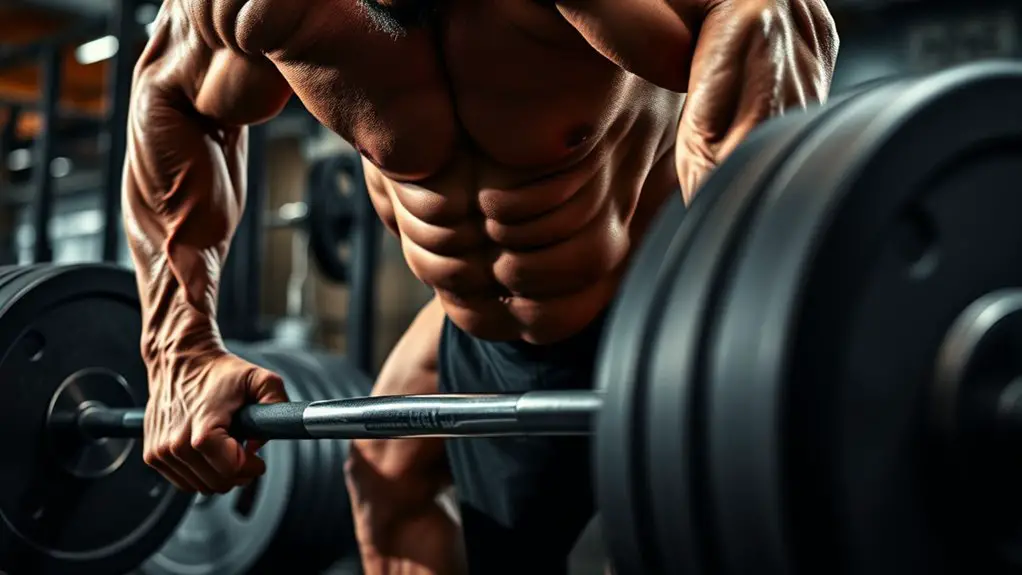
When you perform common exercises, understanding the mechanics of leverage and torque is essential for optimizing your strength output. Each lift applies torque differently, influenced by your body position and the angle of force applied. By analyzing these dynamics, you can enhance your performance and reduce the risk of injury.
Lever Mechanics in Lifts
While many lifters focus primarily on the amount of weight lifted, the mechanics of leverage play an essential role in determining the effectiveness of various exercises. Understanding lever principles can greatly enhance your training. Here are four key aspects of lever mechanics in lifts:
- Point of Rotation: The joints act as fulcrums, affecting torque and muscle recruitment.
- Length of Lever Arm: A longer lever arm increases the distance a weight must move, impacting force application.
- Mechanical Advantage: Shorter lever arms can provide a mechanical advantage, allowing for more efficient lifting.
- Body Positioning: Adjusting your stance or grip can alter leverage and torque dynamics, optimizing performance.
Torque Application in Movements
Understanding how torque applies to common exercises is essential for maximizing your training results. By analyzing torque application, you’ll improve movement efficiency and enhance strength gains. Torque is generated by the force exerted at a distance from the joint axis, influencing your ability to lift effectively.
| Exercise | Torque Application | Movement Efficiency |
|---|---|---|
| Squat | Hip and knee joint torque | Improved power output |
| Bench Press | Shoulder joint torque | Enhanced stability |
| Deadlift | Hip hinge torque | Ideal force transfer |
| Overhead Press | Shoulder stability torque | Increased lift capacity |
| Pull-up | Elbow joint torque | Better muscle engagement |
The Importance of Joint Angles in Leverage
Understanding joint angles is essential for maximizing leverage and force production during your workouts. Ideal joint positioning not only enhances mechanical advantage but also minimizes the risk of injury. By adjusting your body alignment, you can greatly influence the effectiveness of each exercise.
Optimal Joint Positioning
Ideal joint positioning plays an essential role in maximizing leverage during strength training exercises. When you focus on ideal muscle alignment and joint stability, you can greatly enhance your performance. Here are four key factors to take into account:
- Joint Angles: Maintain specific angles that promote ideal force application.
- Body Mechanics: Verify your body follows a natural movement path to prevent unnecessary strain.
- Load Distribution: Balance loads across joints to enhance stability and reduce injury risk.
- Range of Motion: Utilize the full range of motion while maintaining joint integrity to maximize strength output.
Impact on Force Production
Achieving ideal joint positioning is not just about stability; it directly influences force production during strength training. When you optimize joint angles, you enhance torque generation, which is essential for maximizing your lifting potential. Research shows that certain angles improve the leverage of your muscles, allowing for more efficient force generation. For instance, maintaining a 90-degree knee angle during squats can greatly increase your ability to produce torque, ultimately leading to greater strength outcomes. Conversely, poor joint positioning can hinder your performance and increase injury risk. By understanding the relationship between joint angles and torque optimization, you can tailor your workouts to guarantee that you’re generating the most force possible, enhancing both your strength gains and overall performance in the gym.
Tips for Applying Torque and Leverage in Your Workouts
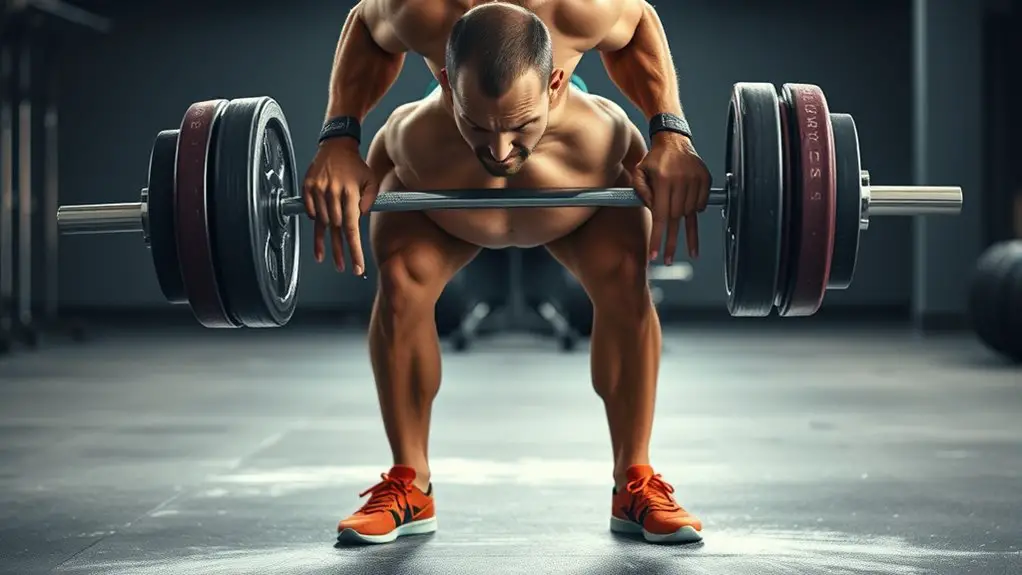
When you incorporate torque and leverage into your workouts, you can greatly enhance your strength training effectiveness. Understanding how these principles interact with your body mechanics allows for performance optimization through strategic exercise variations. Here are some tips to apply torque and leverage effectively:
- Adjust Grip Width: Experiment with different grip widths to maximize torque during lifts, impacting muscle engagement.
- Utilize Angled Movements: Incorporate exercises like incline presses or cable crossovers to exploit leverage advantages.
- Vary Your Stance: Use varied stances—narrow vs. wide—to alter leverage, focusing on different muscle groups.
- Engage Core Muscles: A strong core stabilizes your body, allowing for better torque application during dynamic movements.
Real-Life Examples of Torque and Leverage Impacting Performance
Understanding how torque and leverage manifest in practical scenarios can considerably inform your training regimen. For instance, consider a bench press: the angle of your elbows relative to your torso greatly affects torque. A wider grip increases torque at the shoulder joint, but it may reduce the effective weight lifted due to leverage disadvantages.
In real-world scenarios, athletes often manipulate body position to enhance performance outcomes. For example, powerlifters employ specific stances and grip widths to maximize leverage during lifts. Similarly, Olympic lifters adjust their setup to improve torque, enabling them to lift heavier weights efficiently.
Research shows that employing ideal leverage can lead to a 10-20% improvement in strength across various exercises. By analyzing these examples, you can make informed adjustments to your technique and enhance your overall performance in the gym.
Frequently Asked Questions
How Do Different Body Types Affect Torque and Leverage in Workouts?
Different body types notably affect torque and leverage during workouts, influencing your overall performance. People with longer limbs may experience greater torque, as the distance from the pivot point to the force applied increases. Additionally, muscle composition plays a role; those with higher ratios of fast-twitch fibers might leverage their strength differently than individuals with more slow-twitch fibers. Understanding your unique body mechanics can help optimize your training and improve your results.
Can Torque and Leverage Prevent Workout Injuries?
While improper form can lead to injuries, leveraging torque correctly can enhance your safety. In biomechanics analysis, understanding how torque and leverage work together helps you optimize your movements, reducing the risk of strain. By adjusting your body position and using the right angles, you’re not just lifting; you’re preventing potential injuries. So, next time you work out, remember: smart leverage can be your best line of defense against injuries.
Are There Specific Warm-Up Exercises for Improving Leverage?
Yes, there are specific warm-up exercises that can enhance your leverage. Incorporating dynamic stretching and mobility drills into your routine is essential. Dynamic stretching improves your range of motion and prepares your muscles for movement, while mobility drills focus on joint flexibility and stability. For instance, hip circles and arm swings can activate key muscle groups and enhance your ability to leverage strength effectively, ultimately leading to better performance and reduced injury risk.
How Do Powerlifters Utilize Torque Differently Than Bodybuilders?
When comparing how powerlifters utilize torque differently than bodybuilders, you’ll notice distinct approaches. Powerlifters focus on powerlifting techniques that maximize torque through ideal positioning and leverage, allowing them to lift heavier weights efficiently. In contrast, bodybuilders employ bodybuilding strategies that emphasize muscle hypertrophy, often using a broader range of motion and varying angles. This difference in focus leads to varying training methods and ultimately affects muscle development and strength outcomes in each discipline.
What Role Does Equipment Play in Torque and Leverage During Exercises?
Equipment design markedly influences torque and leverage during exercises. You’ll notice that different machines or free weights can alter the resistance variation throughout your movement. For instance, angled benches may change the force applied at various joint angles, optimizing muscle engagement. By understanding how equipment affects torque, you can select tools that best suit your training goals, ensuring efficient strength development while minimizing injury risk. Properly chosen equipment can enhance your workout’s effectiveness.
